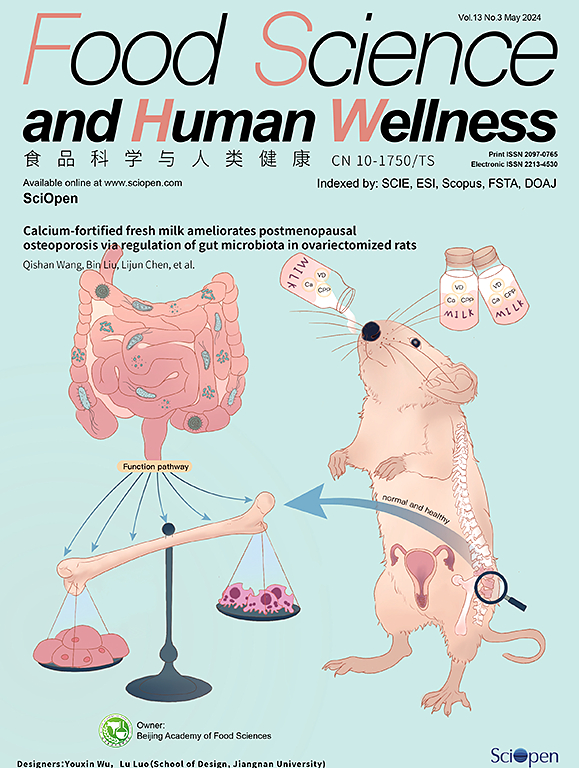Effects of a xylitol-casein complex on insulin resistance and gut microbiota composition in high-fat-diet + streptozotocin-induced type 2 diabetes mellitus mice
IF 7.4
1区 农林科学
Q1 FOOD SCIENCE & TECHNOLOGY
引用次数: 0
Abstract
This study investigated the effects of a xylitol-casein non-covalent complex (XC) on parameters related to type 2 diabetes mellitus (T2DM), in addition to related changes in gut microbiome composition and functions. High-fat-diet (HFD) + streptozotocin (STZ)-induced T2DM mice were treated with xylitol (XY), casein (CN), and XC, after which fecal samples were collected for gut microbiota composition and diversity analyses based on 16S rRNA high-throughput sequencing and multivariate statistics. XC decreased body weight and improved glucose tolerance, insulin sensitivity, pancreas impairment, blood lipid levels, and liver function in T2DM mice compared to XY- and CN-treated mice. Furthermore, XC modulated the α-diversity, β-diversity and gut microbiota composition. Based on Spearman’s correlation analysis, the relative abundances of Alistipes, Bacteroides, and Faecalibaculum were positively correlated and those of Akkermansia, Lactobacillus, Bifidobacterium, and Turicibacter were negatively correlated with the phenotypes related to the improvement of T2DM. In conclusion, we found that XC alleviated insulin resistance by restoring the gut microbiota of T2DM mice. Our results provide strong evidence for the beneficial effects of XC on T2DM and motivation for further investigation in animal models and, eventually, human trials.
木糖醇-酪蛋白复合物对高脂饮食+链脲佐菌素诱导的 2 型糖尿病小鼠胰岛素抵抗和肠道微生物群组成的影响
本研究调查了木糖醇-酪蛋白非共价复合物(XC)对2型糖尿病(T2DM)相关参数的影响,以及肠道微生物组组成和功能的相关变化。用木糖醇(XY)、酪蛋白(CN)和XC治疗高脂饮食(HFD)+链脲佐菌素(STZ)诱导的T2DM小鼠,然后收集粪便样本,根据16S rRNA高通量测序和多元统计分析肠道微生物群的组成和多样性。与 XY 和 CN 处理的小鼠相比,XC 降低了 T2DM 小鼠的体重,改善了葡萄糖耐量、胰岛素敏感性、胰腺损伤、血脂水平和肝功能。此外,XC 还能调节α-多样性、β-多样性和肠道微生物群的组成。根据斯皮尔曼相关分析,Alistipes、Bacteroides和Faecalibaculum的相对丰度与T2DM改善相关的表型呈正相关,而Akkermansia、乳酸杆菌、双歧杆菌和Toricibacter的相对丰度与T2DM改善相关的表型呈负相关。总之,我们发现 XC 通过恢复 T2DM 小鼠的肠道微生物群缓解了胰岛素抵抗。我们的研究结果为 XC 对 T2DM 的有益作用提供了强有力的证据,也为在动物模型中进行进一步研究以及最终进行人体试验提供了动力。
本文章由计算机程序翻译,如有差异,请以英文原文为准。
求助全文
约1分钟内获得全文
求助全文
来源期刊

Food Science and Human Wellness
Agricultural and Biological Sciences-Food Science
CiteScore
8.30
自引率
5.70%
发文量
80
审稿时长
28 days
期刊介绍:
Food Science and Human Wellness is an international peer-reviewed journal that provides a forum for the dissemination of the latest scientific results in food science, nutriology, immunology and cross-field research. Articles must present information that is novel, has high impact and interest, and is of high scientific quality. By their effort, it has been developed to promote the public awareness on diet, advocate healthy diet, reduce the harm caused by unreasonable dietary habit, and directs healthy food development for food industrial producers.
 求助内容:
求助内容: 应助结果提醒方式:
应助结果提醒方式:


